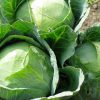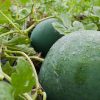Variety: Pata Negra F1
- Early maturing variety
- High yielding with good quality fruits weighing between 7kg and 10kg
- Variety: sentinel F1
- High yielding oblong to blocky shaped zebra variety
- Has uniform fruit shape and weight of 11 to 14 kg
Nursery
- Seeds are raised into seedlings using planting pots
- Pots are filled with well-prepared soil i.e. a mixture of good soil and organic manure
- One seed is put per pot
- Spray preventive fungicides and insecticides to the seedling in the nursery in order to raise health seedlings
- 5g of Mancozeb + 1ml of cypermetrin in 1litre sprayers can be used to mist the seedlings
- Spraying is done once per week
- Water seedling at least once per day
- Seedling are ready for transplanting after three weeks
Main garden
Make furrows in the garden 1 foot wide and 15cm deep. The furrows should be spaced 4metres from each other. The seedlings are spaced 60cm from each other in the sides of the furrows, and it should be done on both sides of the furrows. Organic matter is in co-operated in the furrows and DAP and Physiolith blend put in the holes at the time of transplanting. Put 5grams of The blend per hole. Top dress with CAN at a rate of 10 grams per plant. One months from transplanting top dress with NPK at a rate of 10 grams per plant.
Note: top dressed fertilizers should be place at least 3 inches away from the stems.
Diseases and pests
Melons are always attacked by fungal diseases such as Powderly and downy mildews. Preventive sprays should be employed very often using preventive fungicides such as copper or Mancozeb. At least on spray can be done once a week in a dry season and at least 2 sprays in a wet season. Dosage: 70g of Mancozeb in 20litre spray, 50g of copper in 20 litre sprayer.
Pests
Aphids and melon fruit flies are the major pests of water melon. Aphids suck sap from the leaves leading to curling of the leaves which eventually dry and lead to death of the plant. Dusban always works effectively to kill the aphids. Melon fruit fly mainly manifests at the time of flowering. The adult lays eggs in the flowers which develop eventually into larva (maggot) at the time when the fruit has been formed. The larva eats up the cells of the fruit and bores out of the fruit in order to pupate because it pupates in soil. This results into fruit abortions, rotting of fruits, and bursting of fruits when they are not yet ready. Insecticides that control the fruit flies at this stage also kill the bees which we need for pollination. Insect spray can be best done in the evening when bees activity is done. The best remedy for melon fruit flies is to use fruit fly traps which attract only the fruit flies and kill them without affecting the pollination activity of the bees. 15 pieces of melon traps should be enough for an acre of land.
Harvesting
Ready for harvesting from 100days to 120 days from transplanting. Water melon are harvested as close to full ripeness as possible; this is when the fruit surface touching the ground is light yellow or when the vine closest to the fruit is starting to wilt. The peduncle is cut off to prevent the peduncle from ripping into the skin of the fruit which can result into secondary diseases. Water melon are very prone to cracking or bursting during and after harvest due to rough handling. Water melons should not be thrown during handling, stepped on or stacked too high.




